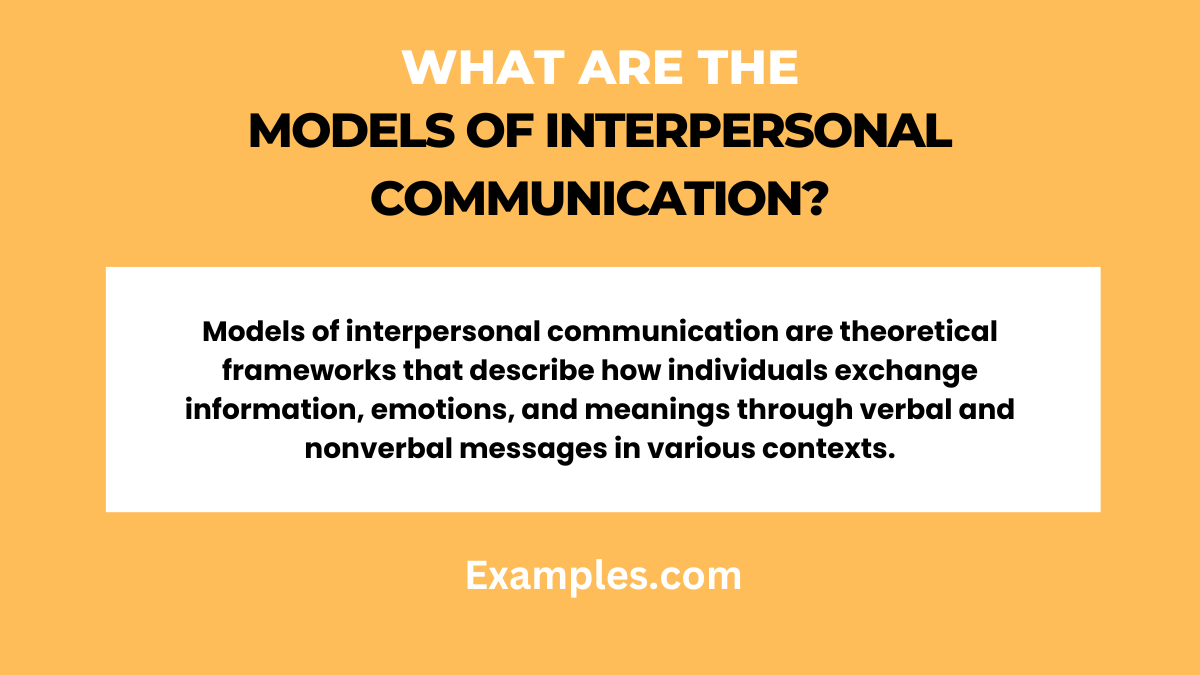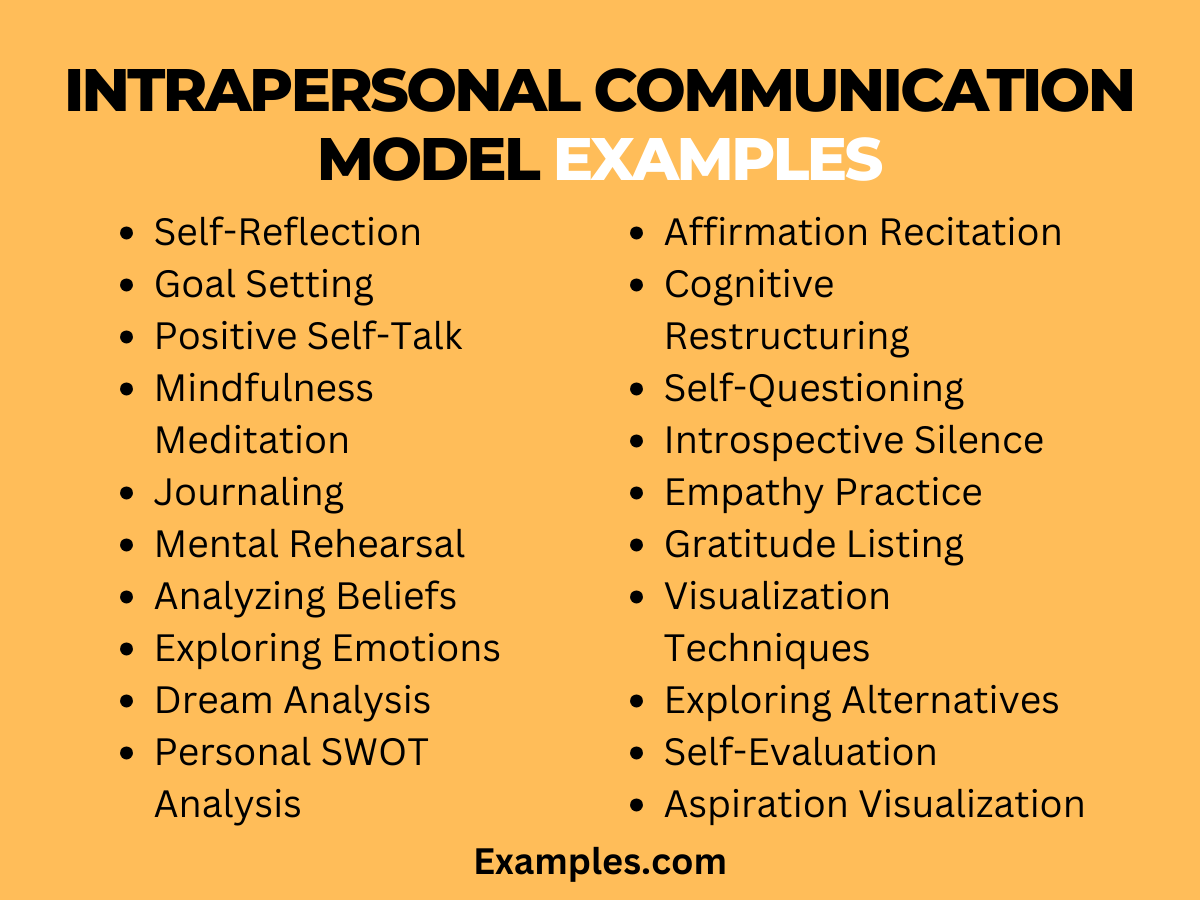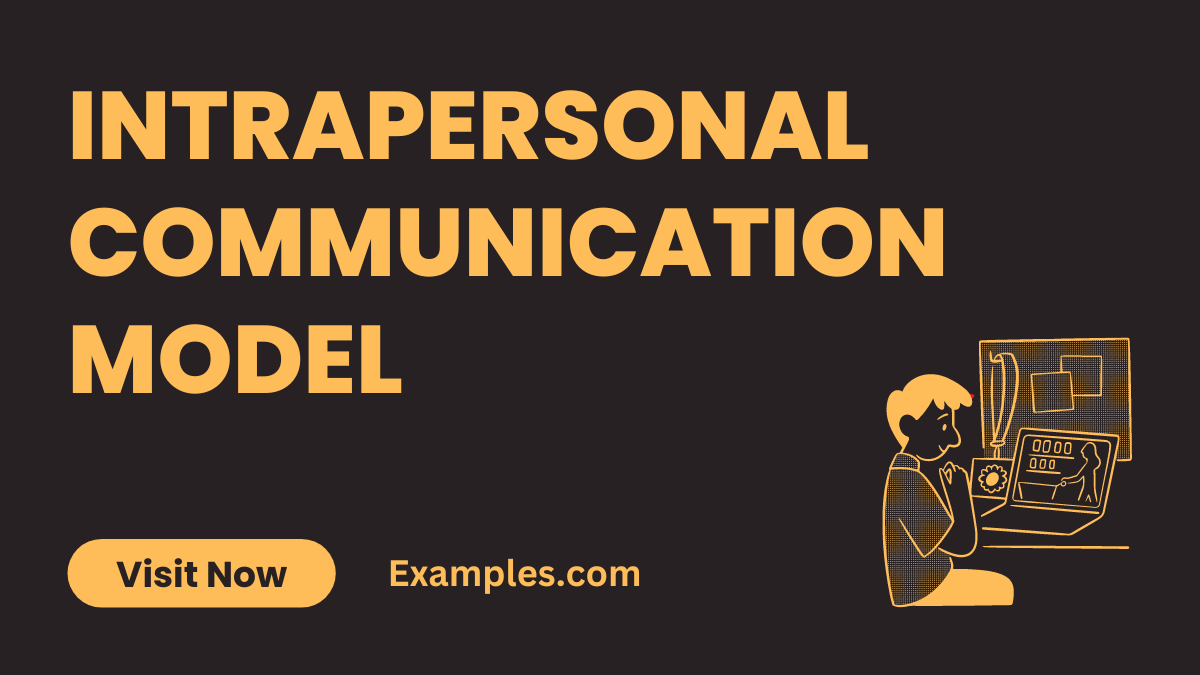19 Intrapersonal Communication Model
The Intrapersonal Communication Model offers a profound understanding of our internal dialogue, shaping our perceptions and decisions. This complete guide delves into the nuances of how we communicate with ourselves, featuring rich, relatable Intrapersonal Communication Examples. It’s a journey into the heart of self-communication, exploring theories, skills, and practical applications. Whether for personal development or professional growth, mastering intrapersonal communication is a vital skill in today’s interconnected world.
What are the Models of Interpersonal Communication?

The Models of Interpersonal Communication refer to various frameworks that explain how people interact and convey information to one another. These models offer insights into the complex process of human interaction, highlighting the ways in which we share, interpret, and understand messages. They encompass a range of theories and concepts, such as the Johari Window Model and Transactional Analysis, each providing a unique perspective on communication dynamics. Understanding these models is crucial for effective communication in both personal and professional settings, enabling individuals to build stronger, more meaningful relationships.
20 Intrapersonal Communication Model Examples

In the realm of Intrapersonal Communication, understanding various models is key to enhancing self-awareness and personal development. This section provides 20 unique and distinct examples of Intrapersonal Communication Models, each accompanied by a detailed explanation and example sentences. These examples highlight the diverse ways in which we engage in internal dialogues, reflecting on thoughts, emotions, and beliefs. They are instrumental in developing Intrapersonal Communication Skills and improving self-understanding.
- Self-Reflection: Taking time each day to reflect on your thoughts and feelings.
Example: “Today, I felt anxious during the meeting. Why did that happen? How can I address this feeling?” - Goal Setting: Creating personal objectives and mentally strategizing ways to achieve them.
Example: “My goal is to improve my public speaking skills. I will start by joining a local speaking club.” - Positive Self-Talk: Replacing negative thoughts with positive affirmations.
Example: “I am capable and strong. I can handle the challenges that come my way.” - Mindfulness Meditation: Practicing being present and aware of your current thoughts and feelings.
Example: “In this moment, I am focused on my breathing and the peacefulness of my surroundings.” - Journaling: Writing down thoughts, feelings, and experiences to understand them better.
Example: “Today’s journal entry will focus on the things I am grateful for in my life.” - Mental Rehearsal: Visualizing a scenario in your mind to prepare for actual events.
Example: “Before my presentation, I’ll visualize myself speaking confidently and clearly.” - Analyzing Beliefs: Examining and questioning your core beliefs and values.
Example: “Do I truly believe this, or is it a belief I’ve adopted from others?” - Exploring Emotions: Identifying and understanding the reasons behind your emotions.
Example: “I feel upset about the feedback. What about it specifically is troubling me?” - Dream Analysis: Interpreting your dreams to gain insights into your subconscious mind.
Example: “My dream about being lost might reflect my uncertainty about my career path.” - Personal SWOT Analysis: Assessing your strengths, weaknesses, opportunities, and threats.
Example: “My strength is adaptability, but I need to work on time management.” - Affirmation Recitation: Regularly repeating empowering statements to build self-confidence.
Example: “I am worthy of success and happiness in all areas of my life.” - Cognitive Restructuring: Changing negative thought patterns to more positive ones.
Example: “Instead of fearing failure, I’ll see it as a learning opportunity.” - Self-Questioning: Challenging your thoughts and actions to gain deeper self-understanding.
Example: “Why do I procrastinate on important tasks? What can I change?” - Introspective Silence: Spending time in silence to listen to your inner voice.
Example: “In these quiet moments, I can truly hear what my heart is saying.” - Empathy Practice: Imagining how you would feel in someone else’s situation.
Example: “If I were in their shoes, how would I feel and react?” - Gratitude Listing: Regularly listing things you are thankful for to foster positivity.
Example: “Today, I am grateful for my health, family, and opportunities.” - Visualization Techniques: Picturing a desired outcome to motivate and guide your actions.
Example: “I visualize myself achieving my fitness goals and feeling energized.” - Exploring Alternatives: Thinking about different ways to approach a situation or problem.
Example: “What are other ways I could handle this conflict at work?” - Self-Evaluation: Regularly assessing your performance and areas for improvement.
Example: “How did I do in managing my stress this week? What can I improve?” - Aspiration Visualization: Imagining your future self and the life you wish to lead.
Example: “I see myself as a successful entrepreneur, making a positive impact.”
10 Models of Intrapersonal Communication

The concept of Intrapersonal Communication encompasses various models that provide insights into how we communicate with ourselves. These models are essential in understanding our internal thought processes, emotions, and how they influence our behavior and interaction with the external world. Let’s delve into 10 significant models that encapsulate the essence of intrapersonal communication.
1. Self-Reflection Model
The Self-Reflection Model emphasizes introspection, where one contemplates their Intrapersonal Communication Skills. It involves analyzing personal experiences, thoughts, and emotions, leading to enhanced self-awareness and personal growth. This model is crucial in developing a deeper understanding of one’s internal dialogue and emotional intelligence.
2. Cognitive Behavioral Model
In the Cognitive Behavioral Model, the focus is on how thoughts influence emotions and behaviors. It’s a key component in Intrapersonal Communication Theories, highlighting the importance of modifying negative thought patterns to improve overall mental well-being and personal communication strategies.
3. Self-Regulation Model
The Self-Regulation Model centers on controlling and managing thoughts, emotions, and behaviors to achieve goals. It’s integral to Intrapersonal Communication Activities, encouraging self-discipline and effective management of internal dialogues for better emotional and behavioral outcomes.
4. Mindfulness-Based Model
This model advocates for present-moment awareness and non-judgmental observation of thoughts and feelings, crucial in Intrapersonal Communication Skills. It aids in reducing stress and improving mental clarity, enhancing the quality of internal communication.
5. Self-Perception Theory
Self-Perception Theory involves forming attitudes by observing one’s own behavior. It’s significant in understanding Intrapersonal Communication Examples, as it helps in aligning actions with internal beliefs and attitudes, thereby influencing self-image and confidence.
6. Narrative Identity Model
The Narrative Identity Model focuses on forming a cohesive self-identity through personal stories and experiences. This approach is vital in Intrapersonal Communication, as it assists individuals in understanding and articulating their life’s narrative, impacting their self-perception and communication.
7. Emotional Intelligence Model
Emphasizing the monitoring and understanding of one’s own emotions, the Emotional Intelligence Model is a cornerstone of Intrapersonal Communication Concepts. It enhances the ability to manage emotions effectively, crucial for personal development and interpersonal interactions.
8. Johari Window Model
Although traditionally used in interpersonal contexts, the Johari Window Model is beneficial intrapersonally for identifying unknown aspects of oneself. It’s important in Intrapersonal Communication for enhancing self-awareness and understanding the hidden facets of our personality.
9. Transactional Analysis Model
This model analyzes internal dialogues based on ego states – Parent, Adult, Child. It’s essential in Intrapersonal Communication Theories for understanding complex internal conversations and emotional responses, leading to better self-understanding and communication effectiveness.
10. Maslow’s Hierarchy of Needs Model
Maslow’s model, often linked to motivation, is key in Intrapersonal Communication for understanding how different needs influence our thoughts and behaviors. It highlights the importance of fulfilling basic needs to achieve higher levels of self-actualization and internal harmony.
How do you Describe the Intrapersonal Communication Model?

The Intrapersonal Communication Model is a multifaceted concept central to understanding how individuals process and interpret their internal thoughts and feelings. This model is integral to personal development, self-awareness, and emotional intelligence, playing a crucial role in how we perceive ourselves and interact with the world.
Core Elements of the Model
At its essence, intrapersonal communication involves the internal processes of thinking, feeling, and self-talking. It encompasses:
- Thought Processing: How we generate, organize, and reflect on our thoughts.
- Emotional Understanding: Recognizing and interpreting our emotional states.
- Self-Concept: The construction of our identity based on our beliefs, experiences, and self-perception.
The Role of Cognitive Processes
Intrapersonal communication is deeply rooted in cognitive processes. It involves:
- Cognitive Dissonance: Managing conflicting thoughts and beliefs.
- Mindfulness: Maintaining a non-judgmental awareness of the present moment.
- Self-Reflection: Engaging in introspection to understand one’s thoughts and emotions.
The Importance of Internal Dialogue
The internal dialogue is the conversation we have with ourselves. It influences:
- Decision Making: Guiding us through the process of making choices.
- Problem Solving: Assisting in the breakdown and analysis of issues.
- Emotional Regulation: Helping to manage and respond to emotional experiences.
Practical Applications
Intrapersonal communication is not just theoretical; its practical applications include:
- Personal Growth: Enhancing self-understanding and development.
- Stress Management: Offering tools for coping with stress and anxiety.
- Goal Setting: Assisting in setting and achieving personal goals.
Improving Intrapersonal Communication
To enhance this form of communication, one can:
- Practice Mindfulness: To increase awareness of one’s thoughts and feelings.
- Journaling: As a tool for self-reflection and clarifying thoughts.
- Engaging in Self-Dialogue: Consciously directing and analyzing one’s internal conversations.
In summary, the Intrapersonal Communication Model is a comprehensive framework that provides deep insights into how we communicate with ourselves. Understanding and improving this form of communication can lead to significant benefits in personal well-being, emotional intelligence, and overall life satisfaction.
In conclusion, the Intrapersonal Communication Model is a powerful tool for personal growth and emotional intelligence. Understanding and applying its principles can transform how we think, feel, and act. This guide has offered insights and practical tips to enhance your internal dialogue, paving the way for better self-awareness, decision-making, and overall well-being. Embrace these models for a journey towards a more introspective and fulfilling life.



